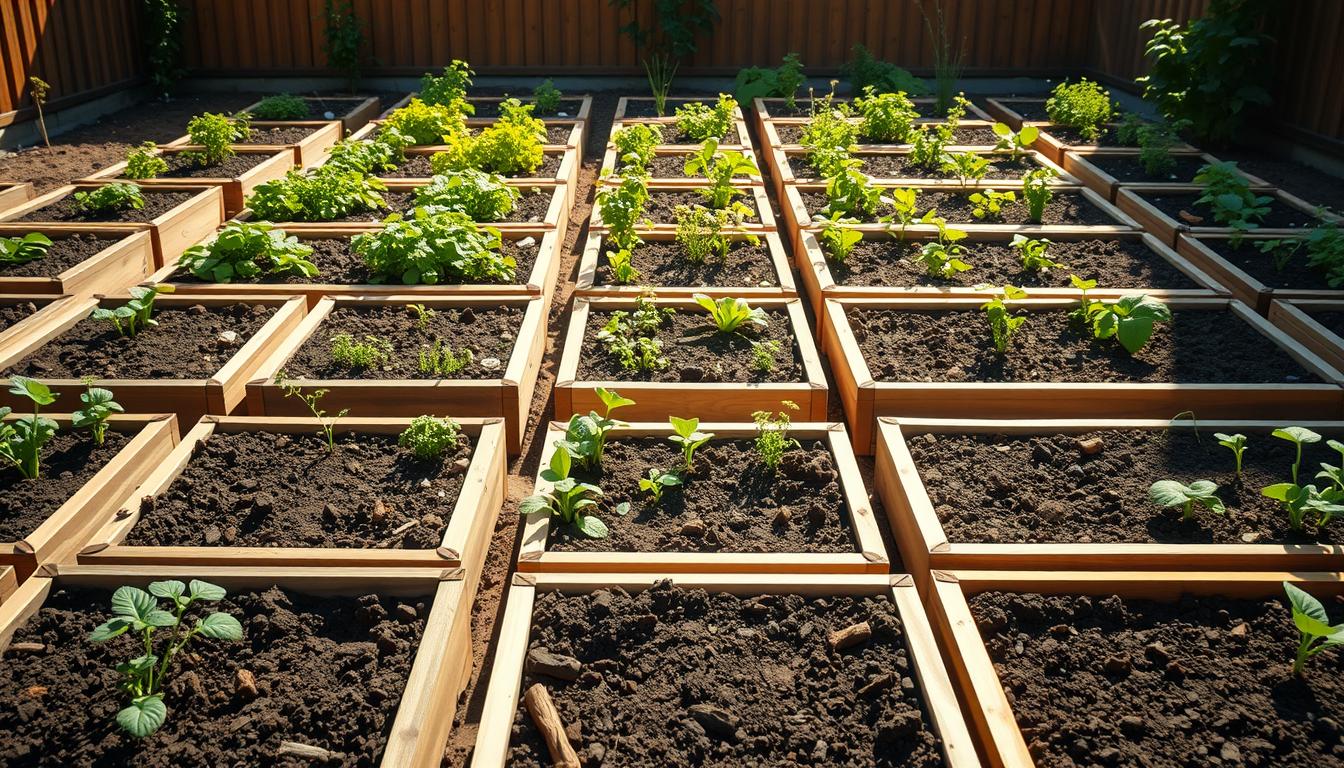Imagine picking fresh veggies from a garden that’s tiny compared to your yard. This isn’t magic – it’s a smart way to grow food at home. It uses squares to organize the garden, great for both newbies and pros.
Whether your space is small or big, this method boosts your harvest. You’ll need less water, less weeding, and less work than old-school gardens. It’s a game-changer for small spaces.
The charm of small space gardening is its simplicity. By choosing the right plants for each square, you can turn any spot into a mini-farm. People in cities, suburbs, and countryside are all using it to grow more food in less space.
Want to see how a simple grid can change your gardening game? Let’s dive into how this clever method makes growing food at home easy for everyone, no matter the space.
The Game-Changing Approach to Home Food Production
Imagine growing twice as much food with half the space, water, and effort. That’s what square foot gardening promises. It turns empty patios and small yards into mini-farms. It’s perfect for those who’ve struggled with traditional gardening or thought they didn’t have enough space.
Why Traditional Gardening Often Falls Short
Traditional row gardening is familiar but has big challenges. It needs a lot of land, often 300-400 square feet, which is hard to find in cities and suburbs.
It also leads to a lot of weeding, which is hard work. Water gets wasted too, as much of it evaporates before reaching the plants.
Many gardeners get tired of putting in a lot of work for little reward. This can lead to burnout. Starting with a small space can be overwhelming, making it hard to start growing food.
How Square Foot Methods Transform Results
Square foot gardening solves these problems with a simple system. It divides space into 1’×1′ squares, making gardening easy for everyone, no matter their skill level.
A 4’×4′ square foot garden can produce as much as a traditional garden eight times its size. This method uses every inch of space well. It also saves water and makes gardening easier.
Water use drops by 80% compared to row gardens. Gardeners spend just a few minutes a day on care, not hours. This makes gardening much simpler.
The method also helps beginners succeed. It gives clear rules for spacing and choosing plants. This makes it easy for anyone to grow a lot of food their first year. Square foot gardening has opened the door to growing food at home for many people.
Understanding Square Foot Gardening Fundamentals
Learning about square foot gardening opens up a world of possibilities in small spaces. It’s not just a trend; it’s a system for efficiency, simplicity, and high yields. Before starting your garden, let’s look at the three key elements that make it great for growing food at home.
Mel Bartholomew’s Revolutionary System
In the 1970s, Mel Bartholomew, a retired engineer, created square foot gardening. He was tired of the waste and hard work in traditional gardens. Bartholomew’s solution was a system that saves space and makes gardening easier.
As an engineer, Bartholomew was precise in his gardening approach. He wondered why plants needed so much space and why gardens used so much water and needed so much weeding. His answer was raised beds, special soil, and a grid system that boosts production while cutting down on work.
Since 1981, Bartholomew’s method has helped millions grow more food in less space. The Square Foot Gardening Foundation keeps his legacy alive, making organic gardening easy for everyone.
The Perfect Soil Mix: Mel’s Mix Explained
Mel’s Mix is at the core of square foot gardening. It’s a mix of compost, vermiculite, and peat moss (or coco coir) in equal parts. This mix makes your soil perfect for plants, no matter what your native soil is like.
The compost gives plants the nutrients they need. Vermiculite keeps the soil moist and loose. Peat moss or coco coir adds organic matter and helps with water retention.
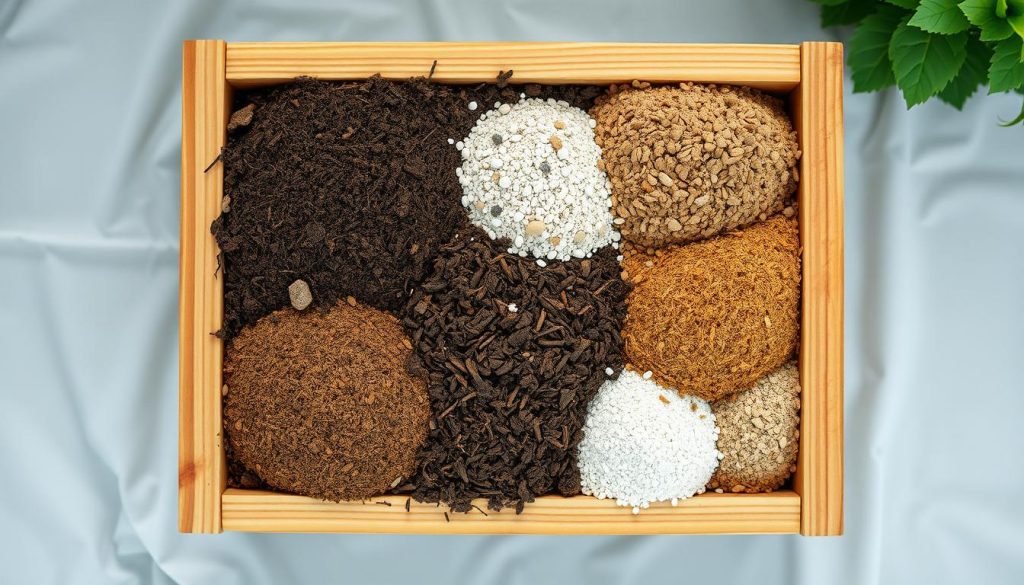
This mix is revolutionary because it creates perfect growing conditions anywhere. It works well with clay, sand, or rocky soil. Mel’s Mix drains well but holds moisture, perfect for most vegetables and herbs.
Grid System: The Heart of the Method
The grid system is what makes square foot gardening unique. It divides each bed into 1-foot by 1-foot squares. This simple tool changes how you plant, care for, and harvest your garden.
Each square is like a mini-garden. You can plant one large plant, four medium plants, nine small plants, or sixteen tiny plants in each square. This spacing prevents overcrowding and makes gardening easier.
The grid also makes it easy to rotate crops and plant new ones. When you harvest a square, you can replant it with something else. This keeps your garden productive all season long. For beginners, this structured approach makes gardening less overwhelming.
Why Small Space Gardeners Fall in Love with This Method
Across America, small space gardeners are finding joy in square foot gardening. This method turns tiny spots into productive gardens. It’s perfect for those with little outdoor space.
Incredible Yields from Minimal Square Footage
First-timers are often amazed by square foot gardening’s results. A 4×4 foot bed can feed a family all season. It’s all about using every inch wisely.
Traditional gardens yield about 0.5 pounds per square foot. Square foot gardens can produce 1.5 to 2 pounds, a huge increase. This makes gardening in small spaces very rewarding.
A study by the National Gardening Association shows a 4×4 square foot garden can earn over $600 a year. For city dwellers, this turns small spaces into valuable food zones.
Less Weeding, Watering, and Work
Square foot gardening also means less work. The raised bed and special soil mix help plants grow well. This reduces common gardening problems.
Weeds find it hard to grow in the loose soil of square foot gardens. When they do, they’re easy to pull out. This saves a lot of time compared to traditional gardens.
This method also saves water, making it great for sustainable gardening. The raised beds and dense planting reduce evaporation. Square foot gardens need 50-80% less water than other gardens.
| Gardening Aspect | Traditional Row Garden | Square Foot Garden | Benefit to Small Spaces |
|---|---|---|---|
| Yield per Square Foot | 0.5 pounds | 1.5-2 pounds | Maximum production from limited area |
| Water Usage | High | 50-80% reduction | Lower utility costs, conservation |
| Weeding Time | Several hours weekly | Minutes weekly | More enjoyment, less labor |
| Accessibility | Ground level, harder to reach | Raised, easier access | Suitable for all ages and abilities |
The design of square foot gardens also helps people with mobility issues. Raised beds and compact layouts make gardening easier. This opens up gardening to seniors, busy professionals, and families.
Building Your First Square Foot Garden
Starting your first square foot garden is easy. It’s a great way to grow your own food, whether you’re new to gardening or have experience. Let’s look at the simple steps to set up your garden.
Selecting the Ideal Location
Finding the right spot for your garden is key. It should get 6-8 hours of sunlight a day. Most veggies need lots of light to grow well.
Make sure it’s close to your house. This makes it easy to water and pick your crops. A 4’×4′ bed can feed a family, and even a single bed can yield a lot.
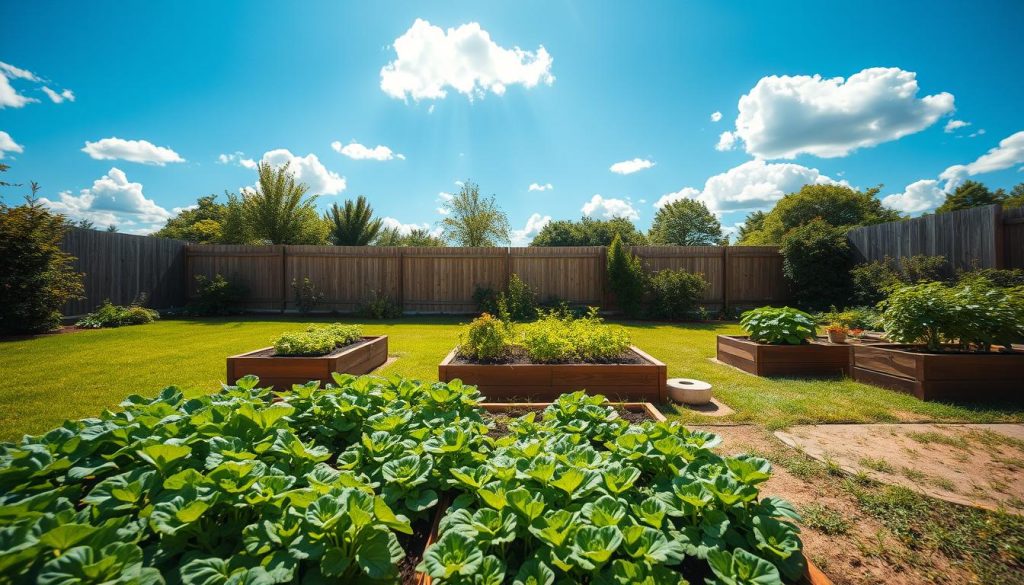
Constructing Simple Raised Beds
Building raised beds is simple. Start with a 4’×4′ size. This lets you reach the center without stepping on the soil. Make them at least 6 inches high, but 10-12 inches is better for veggies with long roots.
Choose materials based on what you need. Cedar and redwood resist rot, while composite boards last long without chemicals. You can also use concrete blocks or brick for sturdy beds.
You’ll need a drill, screws, and a tape measure. Pre-cut lumber from stores can make it even easier. Many will cut boards for you.
Creating and Installing Your Grid
The grid system is what makes square foot gardening special. It turns your garden into 1’×1′ squares, each for a specific plant. This way, you use space well and don’t guess about plant spacing.
Use thin wood lath, nylon cord, or plastic strips for your grid. Place them 12 inches apart in both directions. Attach them to the bed frame with small screws, staples, or hooks.
Make sure the grid is a bit above the soil. This lets you see it all season. It helps you keep plants spaced right and avoid overcrowding.
Mixing and Adding Your Soil
The right soil is crucial for your garden. Mel’s Mix is a blend of compost, peat moss (or coco coir), and vermiculite. It keeps moisture in while draining well and feeding your plants.
For a 4’×4′ bed that’s 6 inches deep, you need about 8 cubic feet of soil mix. Mix it well on a tarp before adding to your bed. Fill it up to an inch from the top to avoid water spills.
| Material | Pros | Cons | Typical Cost |
|---|---|---|---|
| Cedar/Redwood | Natural rot resistance, attractive appearance | Higher initial cost | $40-60 per 4’×4′ bed |
| Pine/Spruce | Affordable, widely available | Shorter lifespan (3-5 years) | $20-30 per 4’×4′ bed |
| Composite Boards | Very long-lasting, no chemicals | Expensive initial investment | $80-120 per 4’×4′ bed |
| Concrete Blocks | Permanent, additional planting spaces in holes | Heavy, industrial appearance | $30-40 per 4’×4′ bed |
Designing a Productive Garden Layout
Creating a good layout for your square foot garden needs careful planning. It’s all about balancing what plants need with how much space you have. This method lets you grow a lot in a little space. Before you start planting, planning your garden layout is key. It helps avoid mistakes and makes your urban garden a success.
Mapping Your Planting Squares
Start with a plan for where each plant goes. Each square can hold a certain number of plants, based on their size. This helps you use space well.
Big plants like tomatoes or cabbage need their own square. Medium plants like lettuce or bush beans can go in four squares. Small plants like carrots fit nine in one square, and tiny ones like radishes can go in sixteen.
Use graph paper or apps to plan your garden. Each square on the paper is one square foot in your garden. This way, you avoid overcrowding and make sure each plant has enough room.
Strategic Plant Placement for Maximum Sun
The sun’s path affects how plants grow. In square foot gardens, placing plants right helps prevent shadows.
Put tall plants like corn or cucumbers on the north side. Medium plants go in the middle, and short ones like lettuce on the south side.
Think about the sun’s angle at different times of the year. Summer sun is higher, while spring and fall sun is lower. Use tall plants to shade plants that don’t like the heat in summer.
Companion Planting in a Grid System
Companion planting is great in square foot gardens. It helps plants grow better by keeping pests away and improving pollination.
Put herbs like basil with tomatoes to make them taste better and keep pests off. Marigolds at the garden edges keep pests away, and nasturtiums draw aphids away from your veggies.
The grid system makes it easy to plan these plant friendships. Just make sure they need the same amount of water and sunlight.
| Plants Per Square | Spacing | Example Crops | Placement Tips |
|---|---|---|---|
| 1 plant | 12 inches apart | Tomatoes, Broccoli, Cabbage | North side or corners |
| 4 plants | 6 inches apart | Lettuce, Swiss Chard, Bush Beans | Middle sections |
| 9 plants | 4 inches apart | Beets, Spinach, Onions | Any location |
| 16 plants | 3 inches apart | Radishes, Carrots, Scallions | Southern edge |
Best Plants for Square Foot Gardening Success
Square foot gardening is great when you pick the right plants. It’s all about spacing and planting in a grid. Even a small 4×4 grid can grow a lot of food all season.
Vegetables That Thrive in Grid Systems
Many vegetables love the square foot gardening setup. They grow well in tight spaces, giving you more food than row gardens. It’s about picking the right veggies for small spaces.
Leafy Greens and Shallow-Rooted Crops
Leafy greens are perfect for square foot gardens. They don’t need much space and grow fast. Lettuce and spinach do great here, with lots of plants per square.
Arugula, kale, and Swiss chard also do well. They grow fast, ready in 30-45 days. Plant them often for a steady supply of greens.
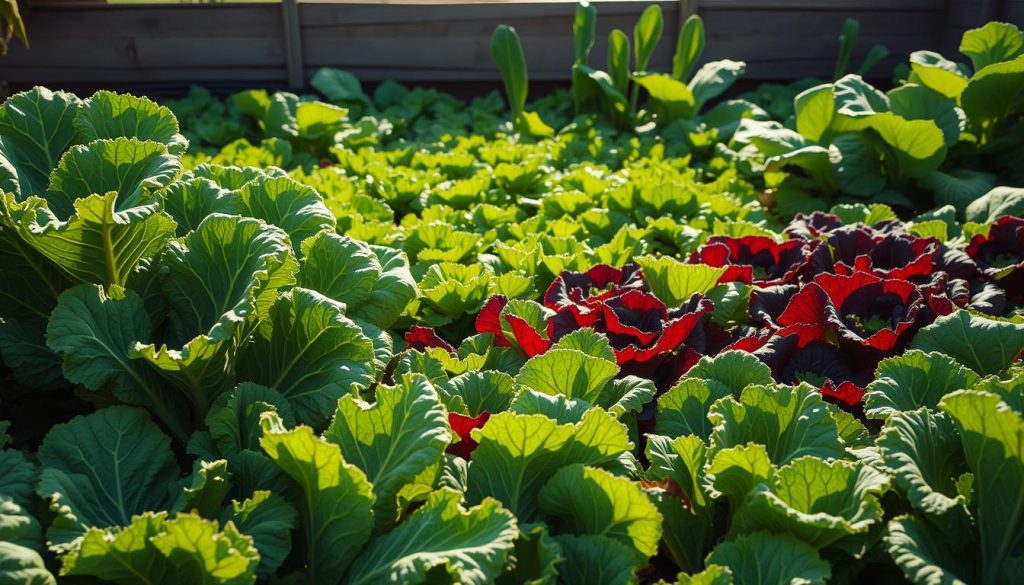
Root veggies like radishes, carrots, and beets love square foot gardens. Radishes grow fast, and carrots and beets need deep soil. They all do well in raised beds.
For fruiting plants, choose bush types. Bush beans and compact peppers need less space. Tomatoes need support but grow well in square foot gardens.
Incorporating Herbs and Beneficial Flowers
Adding herbs and flowers to your garden makes it better. It boosts your harvest and keeps pests away. It’s a win-win for your garden.
Herbs like basil and thyme fit well in square foot gardens. They add flavor and keep pests away. Even big herbs like rosemary can have their own square.
Flowers like marigolds and nasturtiums help your garden. They keep pests away and attract pollinators. This makes your garden more productive and beautiful.
Use about 20% of your space for these plants. They improve pollination and pest control. Your garden becomes a mini-ecosystem, full of life and color.
Year-Round Growing with Succession Planting
Make your garden work all year with succession planting. Unlike regular gardens, square foot gardens can grow food all season. This way, you always have something fresh to eat from your garden.
Knowing when to plant and harvest is key. This lets you grow food continuously. It’s a smart way to garden all year.
Spring Planning and Planting
Spring is when your garden comes alive. Start by adding compost to your beds. This wakes up the soil after winter.
In cooler places (Zones 3-5), start planting in late March or early April. Warmer areas (Zones 7-10) can start in February.
First, plant cool-season crops like peas and lettuce. These do well in spring’s mild weather. Make a plan to replant squares after you harvest.
Start warm-season seedlings indoors while cool-season crops grow outside. This way, you’ll have strong plants ready for warmer weather.
Summer Maintenance and Harvesting
As it gets warmer, your spring crops will be ready to eat. Harvest leafy greens like lettuce by picking the outer leaves. This lets the center keep growing.
When cool-season crops are done, plant warm-season ones like tomatoes. This quick replanting is key to succession planting.
Summer means more water and pests. Water in the morning to save water. Use natural pest control and mulch to keep weeds down.
Fall and Winter Garden Management
Start planning your fall garden in mid-to-late summer. Plant hardy vegetables like kale for cooler weather.
Use simple ways to keep plants warm in winter. Cold frames and row covers help. In warmer areas, many crops grow year-round.
Use cover crops in unused squares for winter. These protect the soil and add nutrients in spring. This method keeps your garden productive all year.
Taking Square Foot Gardening to the Next Level
Take your square foot garden to new heights. This can change how you grow food at home. Start with the basic grid and planting methods. Then, use these advanced strategies to grow more, longer, and with less.
Even in cities, these ideas can turn a small garden into a big food source.
Vertical Growing Structures for Space Maximization
Vertical gardening uses space above your beds for growing. It lets you grow more without taking up more space. This is great for city gardeners.
Use A-frame trellises for climbing plants like cucumbers and peas. For bigger plants like tomatoes, use strong cages or Florida weave systems. They support the plants and keep fruit off the ground.
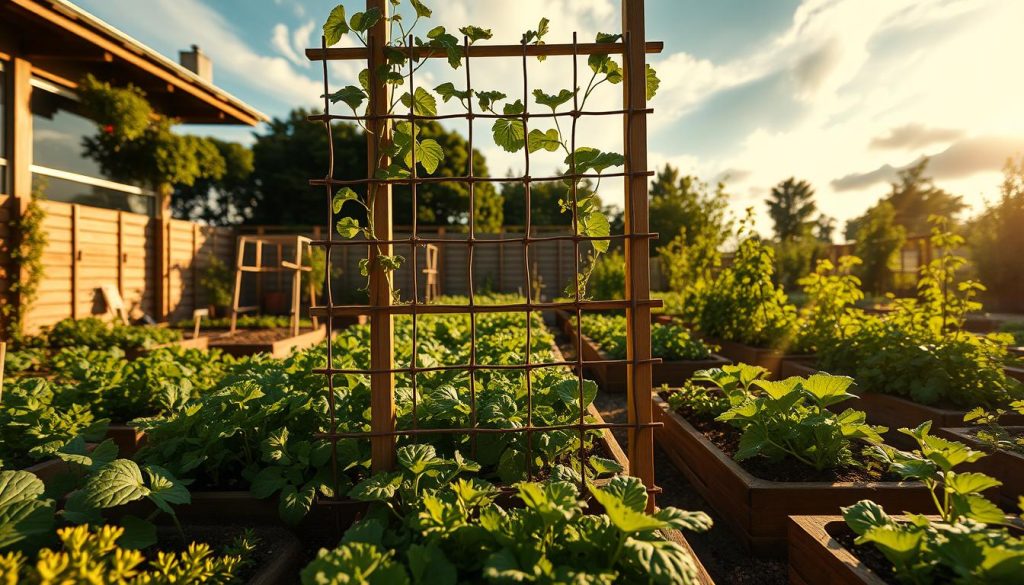
When making vertical parts, make sure they don’t block sunlight unless you want them to. Put tall things on the north side to avoid shadows.
Season Extension Techniques
Don’t limit your harvests to just warm months. Simple tools can help you start earlier and keep growing later.
Cloches protect plants from frost and create a warm spot for seedlings. Hoop houses or low tunnels cover more area.
Cold frames are like mini-greenhouses. They let you grow cool-season crops like spinach and lettuce in winter. The square foot grid fits well in these, keeping your garden organized all year.
Water-Efficient Irrigation Solutions
Square foot gardens use less water than regular gardens. But, special irrigation can make it even better. Drip irrigation gets water right to the roots, cutting down on evaporation and fungal problems.
Ollas are clay pots that slowly water plants. Self-watering systems use wicking beds to reduce how often you need to water. They keep the soil moist.
| Irrigation Method | Water Efficiency | Setup Difficulty | Maintenance | Best For |
|---|---|---|---|---|
| Drip Irrigation | Very High | Moderate | Low | All square foot gardens |
| Ollas | High | Easy | Very Low | Heat-sensitive crops |
| Self-Watering Wicks | High | Moderate | Very Low | Vacation periods |
| Rainwater Harvesting | Moderate | Challenging | Moderate | Sustainable gardens |
Using these advanced techniques, you can grow food all year with less effort. For city gardeners, these methods turn small spaces into productive farms. They help a lot with food for your home.
Overcoming Common Square Foot Gardening Challenges
While square foot gardening has many benefits, it also comes with challenges. These challenges can spread quickly because of the close planting. But, with the right strategies, you can overcome these obstacles and enjoy a successful garden.
Natural Pest Management in Dense Plantings
Dense plantings in square foot gardens attract pests. Insects find it easy to move from one plant to another, making it a feast for them.
Prevention is key to managing pests. Use physical barriers like floating row covers to keep insects away. These lightweight fabrics block flying pests while letting sunlight and water through.
Companion planting also helps in pest control. Herbs like basil, mint, and marigolds confuse pests and hide the scent of other plants. For example, basil with tomatoes not only tastes better but also keeps tomato hornworms away.
When pests show up, use organic treatments. Neem oil spray is effective against many pests and safe for beneficial insects when dry. Introduce natural predators like ladybugs or praying mantises to hunt pests without harming your plants.
Maintaining Soil Fertility in Intensive Systems
Intensive planting in square foot gardens depletes soil nutrients quickly. To keep your garden productive, focus on soil health.
Regular soil testing is crucial. Home test kits can spot nutrient deficiencies early. For a detailed analysis, send samples to your local extension office once a year.
Between plantings, add quality compost to your soil. Compost provides nutrients slowly and improves soil structure. Apply a one-inch layer after harvesting and mix it into the top soil.
For squares needing a break, plant cover crops like clover or buckwheat. These crops protect the soil and add organic matter when turned under. They also prevent nutrient loss during rainy periods.
For specific nutrient needs, use targeted organic amendments. Crushed eggshells are good for tomatoes, while coffee grounds help leafy greens. Kelp meal provides micronutrients and growth stimulants. This balanced approach keeps your garden productive and sustainable.
From Skeptic to Advocate: My Square Foot Gardening Journey
Five years ago, I doubted my friend’s idea of square foot gardening. I thought it sounded too easy. My past gardening experiences were tough, with back pain, weeds, and small harvests. So, I decided to try it out with a 4×4 raised bed garden.
That first season was a game-changer. My square foot garden needed almost no weeding, unlike my big garden. I was amazed to see it produce almost as many tomatoes as my big garden!
I made mistakes, like planting too close together. My zucchini took over. But I learned to follow the spacing rules, which are based on what plants really need.
Now, we have six raised beds that give us most of our veggies all year. Square foot gardening changed my garden and how I see food. It makes me enjoy every carrot and pepper more than before.
Anyone can start square foot gardening, no matter the space. It works for small balconies or big yards. If you’re unsure, start with one bed. You’ll see the difference and might become a fan of this gardening method.

